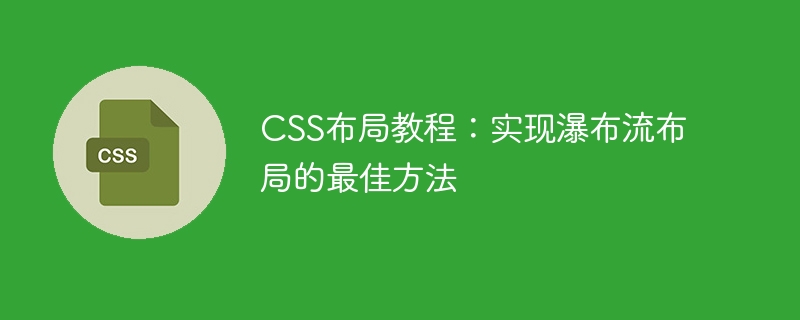Home >Web Front-end >CSS Tutorial >CSS Layout Tutorial: The Best Way to Implement Waterfall Layout
CSS Layout Tutorial: The Best Way to Implement Waterfall Layout
- WBOYWBOYWBOYWBOYWBOYWBOYWBOYWBOYWBOYWBOYWBOYWBOYWBOriginal
- 2023-10-20 13:10:501928browse

CSS Layout Tutorial: The best way to implement waterfall flow layout, specific code examples are required
Waterfall layout (Waterfall Layout) is a common web page layout method , which can arrange elements of different sizes in multiple columns, giving people a waterfall-like feeling. This layout is often used for web pages that need to display multiple items, such as photo walls and product displays. This article will introduce how to use CSS to implement waterfall layout and give specific code examples.
1. Building the HTML structure
First, we need to build the basic HTML structure. In the page, we use a parent container and multiple child containers to implement waterfall flow layout. The parent container is responsible for positioning and layout, while the child container is used to place specific content.
<div class="waterfall-container"> <div class="waterfall-item"></div> <div class="waterfall-item"></div> <div class="waterfall-item"></div> <!-- 以此类推,可以根据需要添加更多的子容器 --> </div>
In the example, we use waterfall-container as the class name of the parent container and waterfall-item as the class name of the child container. You can adjust these class names according to actual conditions.
2. CSS style setting
Next, we need to use CSS to set the style to achieve the effect of waterfall flow layout. First, we set a width and center alignment for the parent container, and then set the width, spacing, and positioning of the child container.
.waterfall-container {
max-width: 900px; /* 设置最大宽度 */
margin: 0 auto; /* 居中对齐 */
}
.waterfall-item {
width: 300px; /* 设置子容器的宽度,可以根据实际需求进行调整 */
margin-bottom: 20px; /* 设置子容器的底部间距,可以根据实际需求进行调整 */
position: relative; /* 设置子容器的定位为相对定位 */
}In the above example, we set the maximum width of the parent container to 900px and center align it. For the subcontainer, we set a fixed width and bottom spacing, and set the positioning to relative positioning.
3. Writing JavaScript code
After using CSS to implement the basic waterfall flow layout, we can use JavaScript to handle the positioning of sub-containers when necessary to achieve dynamic effects. In this example, we will use the jQuery library to make things easier.
First, introduce the jQuery library into the page, and then write the following code:
$(window).on('load', function() {
$('.waterfall-container').each(function() {
var $container = $(this);
var $items = $container.find('.waterfall-item');
var columnCount = Math.floor($container.width() / $items.outerWidth(true));
var columns = [];
for (var i = 0; i < columnCount; i++) {
columns.push(0); // 初始化每一列的高度为0
}
$items.each(function() {
var $item = $(this);
var shortestColumnIndex = 0;
var shortestColumnHeight = columns[0];
for (var i = 0; i < columnCount; i++) {
if (columns[i] < shortestColumnHeight) {
shortestColumnHeight = columns[i];
shortestColumnIndex = i;
}
}
$item.css({
top: shortestColumnHeight,
left: shortestColumnIndex * $items.outerWidth(true)
});
columns[shortestColumnIndex] += $item.outerHeight(true); // 更新最短列的高度
});
});
});The above code uses jQuery’s $(window).on('load', function() {}) event, ensure that the page is fully loaded before executing the layout code. Next, we used the .each() method to traverse each parent container and find the corresponding child container. We then calculated the number of columns the parent container could hold and initialized the height of each column to 0.
Next, we loop through each sub-container and find the column with the shortest current height. We then position the current subcontainer to the correct location based on the height and index of the shortest column. Finally, we update the height of the shortest column to accommodate the change after placing the new subcontainer.
4. Practical Demonstration and Effect
After the above code is completed, you can integrate the HTML, CSS and JavaScript codes into an HTML file and run it in the browser. You will see that the sub-containers on the page are arranged in a waterfall layout.
By adjusting the width of the parent container and the width of the child container, you can further customize and optimize the effect of the waterfall flow layout to suit different needs and devices.
Summary
This article introduces the best way to use CSS to implement waterfall flow layout, and gives specific code examples. By using a combination of CSS and JavaScript, we can easily display multiple elements on a web page in the form of a waterfall. I hope this article will be helpful for you to learn and apply waterfall flow layout!
The above is the detailed content of CSS Layout Tutorial: The Best Way to Implement Waterfall Layout. For more information, please follow other related articles on the PHP Chinese website!
Related articles
See more- CSS layout is centered and aligned, with fixed width on the left and adaptive on the right.
- WeChat applet implements waterfall flow layout and unlimited loading
- Waterfall flow layout and infinite loading picture album effect
- Detailed explanation of commonly used text layout-related properties in CSS layout

